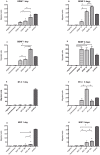Neurotrophin-induced migration and neuronal differentiation of multipotent astrocytic stem cells in vitro
- PMID: 23251608
- PMCID: PMC3520915
- DOI: 10.1371/journal.pone.0051706
Neurotrophin-induced migration and neuronal differentiation of multipotent astrocytic stem cells in vitro
Abstract
Hypoxic ischemic encephalopathy (HIE) affects 2-3 per 1000 full-term neonates. Up to 75% of newborns with severe HIE die or have severe neurological handicaps. Stem cell therapy offers the potential to replace HIE-damaged cells and enhances the autoregeneration process. Our laboratory implanted Multipotent Astrocytic Stem Cells (MASCs) into a neonatal rat model of hypoxia-ischemia (HI) and demonstrated that MASCs move to areas of injury in the cortex and hippocampus. However, only a small proportion of the implanted MASCs differentiated into neurons. MASCs injected into control pups did not move into the cortex or differentiate into neurons. We do not know the mechanism by which the MASCs moved from the site of injection to the injured cortex. We found neurotrophins present after the hypoxic-ischemic milieu and hypothesized that neurotrophins could enhance the migration and differentiation of MASCs. Using a Boyden chamber device, we demonstrated that neurotrophins potentiate the in vitro migration of stem cells. NGF, GDNF, BDNF and NT-3 increased stem cell migration when compared to a chemokinesis control. Also, MASCs had increased differentiation toward neuronal phenotypes when these neurotrophins were added to MASC culture tissue. Due to this finding, we believed neurotrophins could guide migration and differentiation of stem cell transplants after brain injury.
Conflict of interest statement
Figures


Similar articles
-
Transplantation of multipotent astrocytic stem cells into a rat model of neonatal hypoxic-ischemic encephalopathy.Brain Res. 2006 Sep 27;1112(1):99-105. doi: 10.1016/j.brainres.2006.07.014. Epub 2006 Aug 21. Brain Res. 2006. PMID: 16919606
-
[Transplantation of human fetal neural stem cells into cerebral ventricle of the neonatal rat following hypoxic-ischemic injury: survival, migration and differentiation].Zhonghua Er Ke Za Zhi. 2005 Aug;43(8):576-9. Zhonghua Er Ke Za Zhi. 2005. PMID: 16191264 Chinese.
-
Neurons and astrocytes secrete factors that cause stem cells to differentiate into neurons and astrocytes, respectively.Mol Cell Neurosci. 2003 Jul;23(3):414-26. doi: 10.1016/s1044-7431(03)00068-x. Mol Cell Neurosci. 2003. PMID: 12837625
-
Regulation of neuropeptide expression in the brain by neurotrophins. Potential role in vivo.Mol Neurobiol. 1995 Apr-Jun;10(2-3):135-49. doi: 10.1007/BF02740672. Mol Neurobiol. 1995. PMID: 7576304 Review.
-
The heterogeneity of adult neural stem cells and the emerging complexity of their niche.Cold Spring Harb Symp Quant Biol. 2008;73:357-65. doi: 10.1101/sqb.2008.73.019. Epub 2008 Nov 6. Cold Spring Harb Symp Quant Biol. 2008. PMID: 19022766 Review.
Cited by
-
Pancreatic stellate cells promote hapto-migration of cancer cells through collagen I-mediated signalling pathway.Br J Cancer. 2014 Jan 21;110(2):409-20. doi: 10.1038/bjc.2013.706. Epub 2013 Nov 7. Br J Cancer. 2014. PMID: 24201748 Free PMC article.
-
Microcontact Printing of Cholinergic Neurons in Organotypic Brain Slices.Front Neurol. 2021 Nov 17;12:775621. doi: 10.3389/fneur.2021.775621. eCollection 2021. Front Neurol. 2021. PMID: 34867765 Free PMC article.
-
Humoral activity of cord blood-derived stem/progenitor cells: implications for stem cell-based adjuvant therapy of neurodegenerative disorders.PLoS One. 2013 Dec 31;8(12):e83833. doi: 10.1371/journal.pone.0083833. eCollection 2013. PLoS One. 2013. PMID: 24391835 Free PMC article.
-
AAV-Syn-BDNF-EGFP Virus Construct Exerts Neuroprotective Action on the Hippocampal Neural Network during Hypoxia In Vitro.Int J Mol Sci. 2018 Aug 5;19(8):2295. doi: 10.3390/ijms19082295. Int J Mol Sci. 2018. PMID: 30081596 Free PMC article.
-
BDNF-TrkB axis regulates migration of the lateral line primordium and modulates the maintenance of mechanoreceptor progenitors.PLoS One. 2015 Mar 9;10(3):e0119711. doi: 10.1371/journal.pone.0119711. eCollection 2015. PLoS One. 2015. PMID: 25751404 Free PMC article.
References
-
- Beilharz EJ, Klempt ND, Klempt M, Sirimanne E, Dragunow M, et al. (1993) Differential expression of insulin-like growth factor binding proteins (IGFBP) 4 and 5 mRNA in the rat brain after transient hypoxic-ischemic injury. Brain Res Mol Brain Res 18: 209–215. - PubMed
-
- Shankaran S (2002) The postnatal management of the asphyxiated term infant. Clin Perinatol 29: 675–692. - PubMed
-
- Shankaran S, Laptook AR, Ehrenkranz RA, Tyson JE, McDonald SA, et al. (2005) Whole-body hypothermia for neonates with hypoxic-ischemic encephalopathy. N Engl J Med 353: 1574–1584. - PubMed
Publication types
MeSH terms
Substances
LinkOut - more resources
Full Text Sources
Research Materials

